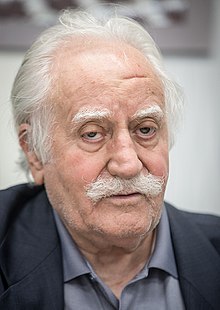Mahmoud Farshchian
Mahmoud Farshchian | |
|---|---|
 Farshchian in 2017 | |
| Born | 24 January 1930 Isfahan, Iran |
| Nationality | Iranian |
| Known for | Painting |
| Website | Personal website |
Mahmoud Farshchian (Persian: محمود فرشچیان, Mahmud Faršciyân; born 24 January 1930) is a master of Persian painting (Miniature) miniatures. He was born in the city of Isfahan in Iran, and it was here where he learned art, painting, and sculpting.
His paintings have been hosted by several museums and exhibitions worldwide.[1]
Life[]
Master Mahmoud Farshchian was born in the city of Isfahan on January 24, 1930. His father, a rug merchant, was an art aficionado who instilled a love for the arts in his son. Young Mahmoud showed an interest in arts quite early in life and studied under the tutelage of Haji Mirza-Agha Emami and Isa Bahadori for several years. After receiving his diploma from Isfahan's high school for the fine arts, Farshchian left for Europe, where he studied the works of the great Western masters of Painting. Consequently, he developed an innovative artistic style with universal appeal.
Upon his return to Iran, he began to work at the National Institute of Fine Arts (which later became the Ministry of Art and Culture) and, in time, was appointed director of the Department of National Arts and professor at the university of Tehran's School of Fine Arts. All the while, word of his exemplary works spread far and wide beyond national borders. He has been exhibited in 57 individual shows and 86 group shows in Iran, Europe, America and Asian countries. His works are represented in several museums and major collections worldwide. He has been awarded more than ten prizes by various art institutes and cultural centers. He has a doctorate (grade 1 in arts) in Iranian painting and Islamic arts from the High Council of Culture and Art.
"The Museum of Master Mahmoud Farshchian", is a museum devoted to the works of the master, which has been set up by the Cultural Heritage Foundation in the Sa'dabad Cultural Complex in Tehran, inaugurated in 2001.[citation needed]
The design of the Zarih (the box-like latticed enclosure which is placed on top of the tomb), roof, door and cellar in the shrine of the 8th shiite Imam, Ali ibn Mus'ar-Reza in Mashhad and his membership in the committee supervising the construction of the shrine, is another artistic work of the master.
Farshchian resides in New Jersey. His son Alimorad Farshchian is a doctor.
Style[]
Farshchian is the founder of his own school in Iranian Painting, which adheres to classical form while making use of new techniques to broaden the scope of Iranian painting. He has brought new life to this art form and has freed it from the symbiotic relationship it has historically had with poetry and literature, to give it an independence it had not previously enjoyed. His powerful and innovative paintings are dynamic, expansive and vibrant canvases with an appealing fusion of the traditional and the modern, which are constituents of his unique style of painting.
Master Farshchian has played a decisive role in introducing Iranian art to the international art scene. He has been invited to speak and exhibit at numerous universities and art institutes. There have been six books and countless articles published about Farshchian's works. In 2007 British-Omani designer Amr Ali used Farschian's painting The Fifth Day of Creation as the main influence for his collection presented at London Fashion Week.[2]
Farshchian and Rumi[]
Farshchian's work Shams and Rumi has been inspired by one of Rumi's poems. Special colors have been used in the painting to feature the mystical and spiritual relationship that existed between Shams and Rumi. The painting took two months to complete in the U.S. and was unveiled at the Farshchian Art and Cultural Complex in Isfahan on August 2, 2007.[citation needed]
Books[]
- Painting and drawing (1976)
- Master Farshchian's paintings in Shahnameh of Ferdowsi (1991)
- Painting of the great heroes of Shahnameh (1991)
- Mahmoud Farshchian Volume II Selected By UNESCO (1991)
- Master Farshchian's paintings in Divan of Hafez (2002)
- Master Farshchian's paintings in Rubaiyat of Omar Khayyam (2004)
- Mahmoud Farshchian Volume III Selected By UNESCO (2004)
Awards[]
- 2011 - DeviantART, Daily Deviation for Apr 6.
- 2010 - DeviantART, Daily Deviation for Jun 26.
- 2010 - DeviantART, Daily Deviation for Mar 27.
- 2009 - DeviantART, Daily Deviation for Dec 13.
- 2001 - GODIVA Chocolates 75th Anniversary, USA
- 2001 - Who’s Who in the 21st Century, Cambridge, England
- 2000 - Outstanding intellectuals of the 21st Century, Cambridge, England
- 1995 - Gold Medal, Highest Honor
- 1987 - Golden Palm of Europe
- 1985 - Oscar D'Italia, gold statuette.
- 1984 - Vessillo Europa Delle Arte, gold statuette. Italy
- 1983 - Diploma Accadenu'co D'Europa, L’Accademia D'Europa. Italy
- 1983 - Diploma Maestro Di Pittura, II Seminario d'Arte Moderna. Italy
- 1982 - Diploma Di Merito, Universita Delle Arti. Italy
- 1980 - Academia Italia delle Arti e del Lavoro, gold medal.
- 1973 - Ministry of Culture and Art, 1st prize in art. Iran
- 1958 - International Art Festival, gold medal. Belgium
- 1952 - Military Art, gold medal. Iran
References[]
- ^ "Farshchian's latest work unveiled as Iranian art work - IN PHOTOS". Young Journalists Club. 18 September 2013. Retrieved 22 April 2021.
- ^ Patrick Francis. "Amr Ali: Sultan of Style". Jumairah Magazine. p. 136.
External links[]
- People from Isfahan
- University of Tehran faculty
- 1930 births
- Living people
- Iranian still life painters
- Iranian Shia Muslims
- Recipients of the Order of Culture and Art
- Iranian Science and Culture Hall of Fame recipients in Visual Arts